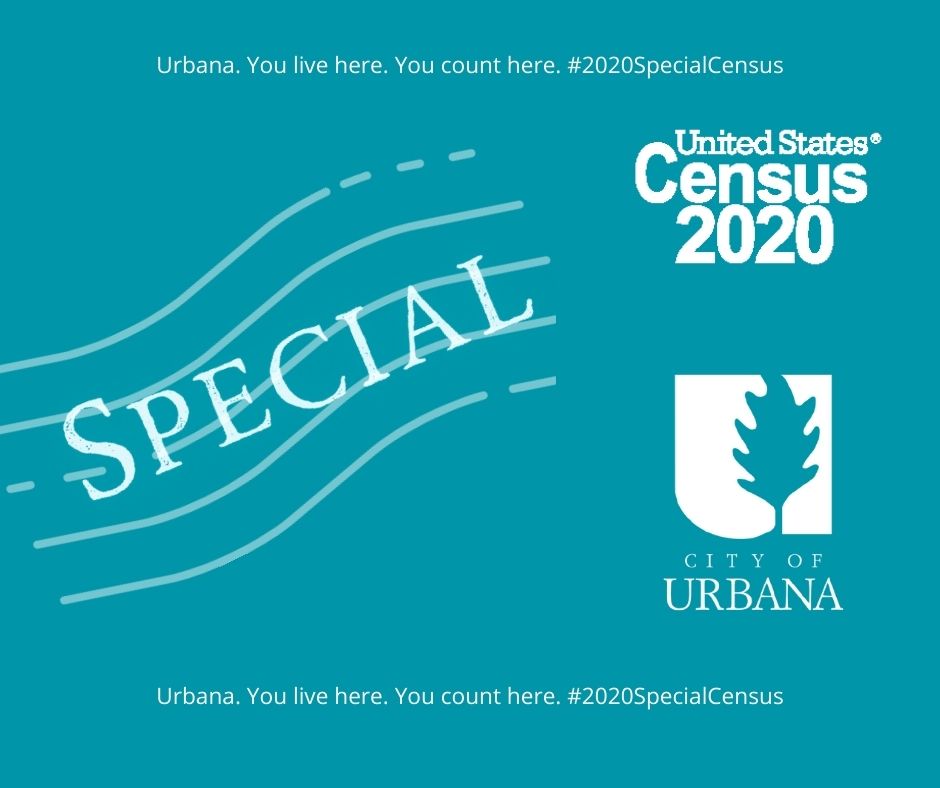Partial Special Census to Be Taken in Urbana

"For Urbana, this is a story about the impact of COVID-19 on the 2020 Census – we’re doing a Partial Special Census because of the pandemic. We’re working with the Chicago Regional Office of the Census Bureau." – Diane Wolfe Marlin, Mayor of Urbana, Illinois
BACKGROUND:
The City of Urbana is located in east central Illinois and, together with our twin city of Champaign, is home to the flagship campus in the University of Illinois system. Enrollment at the University of Illinois at Urbana Champaign (UIUC) is approximately 55,000 students. Typically, UIUC students make up nearly half of the official population of Urbana. Additionally, many faculty, staff and other UIUC employees live here. The student population in Urbana is concentrated in residence halls on campus (there are 6 large university residence halls in Urbana) and in many apartment buildings and houses adjacent to campus.
In March 2020, Illinois Governor Pritzker declared a statewide emergency in response to COVID-19. Public schools (including colleges and universities) were closed to in-person instruction, non-essential businesses shut down or changed practices to reduce spread of the disease, and thousands of employees transitioned to remote working. Locally, thousands of students never returned to campus after spring break in late March; they finished out the semester with remote learning.
The official 2020 Census date was April 1, just a couple weeks after the declaration of the statewide emergency in Illinois. This meant many people who should have been counted as living in Urbana were not present. The result was that instead of the expected modest increase in our population, our official Census 2020 population (38,336) decreased almost 7% compared to the 2010 Census population (41,250.) Closer examination of Census block populations showed the most dramatic decreases in largely student neighborhoods nearest campus.
FURTHER:
Why do Urbana City officials want the Special Census?
We’re conducting a Partial Special Census for two reasons. First, this is an effort to recapture the population that we believe was living here in 2020 but was not counted, largely due to the fact that the University of Illinois switched to remote learning. Thousands of students left town shortly before the Census was taken on April 1, 2020. Second, the Partial Special Census will provide an opportunity to count several new multifamily housing complexes that were built after April 1, 2020.
What are the benefits to the City of Urbana conducting the Partial Special Census?
The Partial Special Census is important because the City receives a significant amount of state and federal funding that is distributed on a per capita basis using Census data. For example, the City’s share of the state motor fuel tax and the State of Illinois income tax (via the Local Government Distributive Fund-LGDF) is distributed based on population. On the federal level, Community Development Block Grant funds and other grants which support programs and services for low-income populations are also distributed on a per capita basis.
If we recapture our population through a more accurate count, we recapture lost revenue. We estimate that we are losing a minimum of $500,000 to $750,000 annually due to the Census 2020 population count; when you multiply that by the 10 years between the official Census counts, it amounts to millions of dollars, which has a big impact on our small community.
How much will it cost and when will it be conducted?
We’ve signed a Memorandum of Agreement with the Decennial Census Management Division, U.S. Census Bureau to conduct a Partial Special Census on October 15, 2024. We’ve identified the Census tract and individual Census blocks in areas that showed the biggest (and unexpected) decrease in the population count. These areas contain an estimated 6,200 people in approximately 3500 housing units. Cities must pay the entire cost of a Partial Special Census, including all Census Bureau costs, which was why we had to carefully select the areas to recount. The more households you count, the more it costs. We have made the required advance payment of $391,680 to the Census Bureau to cover their estimated costs of conducting the census. In addition to the Census Bureau costs, the city must provide secure, temporary office space; furniture, IT equipment and telephones; and we must assist with marketing and promotion of the effort. We’ll also have to hire a person to help coordinate the effort because we do not have the staff capacity to do it in-house. We don’t know yet what the added local expense will be, but we estimate that the total cost of the Partial Special Census could approach $500,000.
